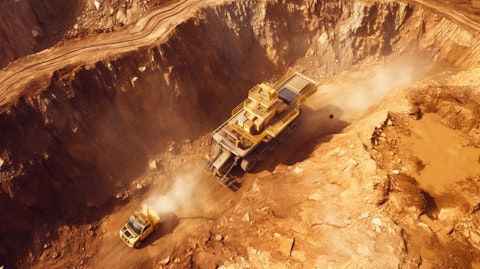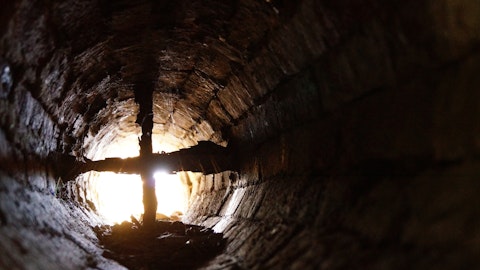Alamos Gold Inc. (NYSE:AGI) Q3 2023 Earnings Call Transcript October 26, 2023
Operator: Good morning. I will now turn the call over to Scott Parsons, Alamos’ Senior Vice President of Investor Relations. Please go ahead.
Scott Parsons: Thank you, operator, and thanks to everybody for attending Alamos’s third quarter 2023 conference call. In addition to myself we have on the line today John McCluskey, President and Chief Executive Officer, Greg Fisher, Chief Financial Officer, Luc Guimond, Chief Operating Officer and Scott R.G. Parsons Vice President of Exploration. We will be referring to a presentation during the conference call that is available through the webcast and on our website. We’d also like to remind everyone that our presentation will be followed by a Q&A session. As we will be making forward-looking statements during the call. Please refer to our cautionary notes included in the presentation, news release and MD&A as well as the risk factors set out in our Annual Information Form.
Technical information in this presentation has been reviewed and approved by Chris Bostwick, our Senior Vice President Technical Services, and a qualified person. Also please bear in mind that all of the dollar amounts mentioned in this conference call are in U.S dollars unless otherwise noted. Now John will provide you with an overview.
John McCluskey: Thank you, Scott. Starting with Slide 3, we delivered another strong quarter with production of 135,400 ounces, exceeding quarterly guidance at costs near the low end of annual guidance. This reflected a solid quarter from Island Gold, and another excellent quarter from the La Yaqui Grande. With year-to-date to the production of 400,000 ounces, we are on pace to achieve a new annual record driven by an outstanding year from the Mulatos district. Given the strong performance we are increasing our production guidance by 5% to a new range of 515,000 to 530,000 ounces. We are also on track to achieve our cost guidance for the year with total cash costs and all in sustaining costs both below the midpoint of guidance year-to-date.
It was also a solid quarter financially, putting us on pace for a record year across a number of metrics including revenue and cash flow from operations. This is giving us the capacity to both grow as a company and generate solid free cash flow, including $37 million in the quarter and $109 million year-to-date. Now looking at Slide 4. We continue to create value from within our growth projects. In August, we released an updated feasibility study on the Lynn Lake Project with a 44% increase in reserves supporting a larger, longer life low cost operation with attractive economics. As part of our balanced approach to growth, our current focus is on the Phase 3+ Expansion at Island gold. But Lynn Lake remains a key part of our longer term growth plans as another long life low cost project in Canada with significant exploration upside, which we expect will further enhance the economics of the project.
In September, we provided another exploration update from Mulatos, where we continue to extend high grade mineralization at PDA. We expect this exploration successful drive a further increase in higher grade reserves and resources as the deposits — at the deposit beyond the million ounces defined at the end of last year. This growth has been incorporated into a development plan to be completed later this year, which we expect will outline another attractive project and significant mine life extension of Mulatos. Construction of the Phase 3 Expansion at Island Gold is advancing well, with the headframe substantially complete and shaft sinking on track to start by year end. The project remains on schedule and on budget, and we expect to be operating from the shaft and extended mill in the first quarter of 2026.
These projects are key drivers of our strong outlook, supporting growing production, declining costs and increased profitability. I’ll now turn the call over to our CFO, Greg Fischer to review our financial performance. Greg.
Greg Fisher: Thank you, John. On Slide 5. During the third quarter we sold 133,000 ounces of gold at an average realized price of $1,932 per ounce $4 above the London PM fix for revenues of $256 million. Total cash costs of $835 per ounce and all in sustaining costs of $1,121 per ounce are both towards the low end of full year guidance. We are on track to once again achieve full year cost guidance. Our reported net earnings of $39 million in the third quarter are $0.10 per share, including unrealized foreign exchange losses of $12 million recorded within deferred taxes and other non-cash losses of $3 million. Excluding these items, our adjusted net earnings were $55 million or $0.14 per share. Operating cash flow before changes in non-cash working capital was $133 million or $0.34 per share.
Given our solid production growth and margin expansion this year, we’re on pace for a record year in terms of revenue, earnings and cash flow from operations. This is driving strong free cash flow generation at a time that we were also investing in growth. This includes $37 million of free cash flow in the quarter and $109 million year-to-date. We expect the strong free cash flow generation to continue while funding the Phase 3+ Expansion. Capital spending totaled $75 million in the quarter and included $27 million in sustaining capital, $42 million of growth capital and $6 million have capitalized exploration. Through the first nine months of the year, capital spending totalled $239 million consistent with our annual guidance. We paid cash taxes of $3 million in the quarter at Mulatos, with a similar payment anticipated in the fourth quarter.
We expect significantly higher cash tax payments in Mexico in 2024, reflecting the strong profitability of Mulatos in 2023, and the $115 million of free cash flow generated from the operation year-to-date. Our balance sheet continues to improve with our cash balance growing to $216 million, a 14% increase in the previous quarter and a 66% increase in the start of the year. We remain debt free and well positioned to fund our growth initiatives. I will now turn the call over to our COO Luc Guimond to provide an overview of our operations.
Luc Guimond : Thank you, Greg. Moving to Slide 6, Young-Davidson produced 45,100 ounces in the quarter, consistent with the previous few quarters with record milling rates of 8,200 tonnes per day, offsetting slightly lower grades. Costs were in line with annual guidance, both in the quarter and year-to-date. Grades are expected to increase in the fourth quarter as my higher grade zones that have been deferred from the third quarter. This is expected to drive production higher in the fourth quarter, putting the operation on track to achieve full year production and cost guidance. The operation continues to be a consistent performer with mine site free cash flow of $31 million in the quarter and $83 million year-to-date. For the third consecutive year, Young-Davidson is on track to deliver more than $100 million in free cash flow.

Over to Slide 7. Island gold produced 36,400 ounces in the quarter, a 19% increase over the second quarter, reflecting both higher grades and tonnes process. It was a strong quarter operationally with mining and milling rates both increasing to exceed annual guidance of 1200 tonnes per day. This helped drive cost down from the second quarter towards the low end of annual guidance. Given the strong year-to-date performance, including production of 100,000 ounces, the operation is well positioned to achieve full year production and cost guidance. Over to Slide 8. Work on the Phase 3+ Expansion continues to progress with the focus on completion of the remaining shaft site surface infrastructure. Construction of the headframe is substantially complete as this construction of the shaft area substation.
Pre commissioning tests on the E-house electrical systems have commenced and construction of the warehouse is well underway. I was sitting in the gallery to be used in the shaft sinking over 50% complete putting the shaft sink on track to start by year end. Over to Slide 9, a total of $35 million of capital related to the Phase 3+ Expansion and capital development was spent in the quarter. The expansion remains on budget with 45% of the total initial capital of $756 million spent and committed to the end of September. With the shaft site surface infrastructure nearing completion, spending a shift towards the shaft sinking later this year, and the mill expansion plan into next year. The overall expansion remains on track to be completed in 2026, transforming Island Gold into one of the largest lowest cost and most profitable mines in Canada.
Moving to Slide 10. At Mulatos, production of 53,900 ounces was down from the second quarter as guided. Reflecting the return to design mining rates for the La Yaqui Grande, and end up mining within the main Mulatos pit. La Yaqui Grande continued to outperform with rates exceeding guidance due to positive grade reconciliation. Mine-site free cash flow was $31 million in the quarter, and an impressive $115 million year-to-date. As previously guided, production is expected to decrease in the fourth quarter reflecting the end of the Mulatos pit and a decrease in grades to guided levels at La Yaqui Grande. With year-to-date production of 164,700 ounces, Mulatos is on track to exceed its full year guidance driven by the strong outperformance from the La Yaqui Grande.
Costs are expected to increase in the fourth quarter but remain within guidance for the full year. Moving to Slide 11, as John noted, the updated feasibility study on the Lynn Lake project has outlined a bigger, longer life and more attractive operation relative to the 2017 study. The updated study incorporates a 44% larger mineral reserve and a 14% larger mill at 8000 tonnes per day. Production over the first 10 years is expected to average 176,000 ounces per year, up 23% from 2017. At lower all-in sustaining costs of $699 per ounce. Over the last several years, we have completed an extensive amount of additional engineering, geotechnical and other work, including obtaining approval of the Environmental Impact Statement back in March. This work has significantly de-risked the project, provides us with a high degree of confidence in the capital and operating cost estimates.
These estimates support attractive base case economics for the project. And our current gold prices represent a 22% after tax internal rate of return. We also see significant upside potential given several near mine and regional exploration opportunities that could be incorporated into the project. Under the current mine plan, the MacLellan and Gordon deposits will be mined over the first 11 years. For the remaining six years we will be processing lower grade stockpiles. With our fleet of mining equipment available from years 11 onward, we are evaluating several nearby targets such as Burnt Timber and Linkwood as additional sources of mill feed. These deposits represent upside to the feasibility study as they would help sustain higher rates of production well beyond the first 10 years.
To review that upside in more detail, I will turn the call over to our VP of exploration, Scott RG Parsons.
Scott Parsons: Thank you, Luc. Over to Slide 12. In August, we provided an exploration update at Lynn Lake, highlighting the significant upside potential across a number of near mines and regional targets. This includes Burnt Timber and Linkwood, two deposits in proximity to the plan mill and MacLellan that could potentially be incorporated into the mine plan. They’re located approximately 28 kilometers away from the MacLellan site and are connected by an all basically offseason road. The two deposits contain 1.6 million ounces of Inferred Resources that were not factored into the feasibility study. Updated geological models have been completed on both deposits, demonstrating the potential for a smaller higher quality mineral resource.
We see excellent potential disruptors to MacLellan built infrastructure after the MacLellan deposits is in line. This would not only help sustain higher rates of production well beyond the first 10 years, but also extend mine life and enhance the project economics. Maynard is a similar stage target with similar potential as another satellite deposit located 20 kilometers by road in the plant mill. All 15 holes drilled at Maynard to-date have intersected gold mineralization over 700-meter strike length and to a depth of 280 meters. This includes higher grade intercepts to just 5.9 grams per tonne over 12 meters. These are just a few examples of the potential that we see across the Lynn Lake Greenstone Belt, a large underexplored district. We starting with a 17-year reserve life based on the updated study.
However, given the opportunities we see across our 58,000-hectare land package, we fully expect the mining in the district well beyond that. Over to Slide 13. In September, we announced the second exploration is updated here in Mulatos, where we continue to have success both regionally and near mine. At PDA step-out drilling is further extended high grade mineralization beyond reserves and resources, which will support additional growth beyond the currently defined 1 million ounces. We are currently working on an updated reserve based on drilling to the end of July and we’ll be incorporating that in an updated development plan to be completed towards the end of the year. We expect it to outline another significant mine life extension in Mulatos.
Based on the success of the program to-date, we’ve increased our exploration budget in Mulatos for the second time this year to $25 million. This includes drilling at PDA through the rest of this year with 50,000 meters planned up from the original budget of 16,000 meters. We are still in the early stages of testing the potential within the broader PDA area. Based on success to-date, and with the deposit open in multiple directions, we see excellent potential for PDA to continue to grow in the years ahead. We also released additional results from the Capulin regional target, target located 4 kilometers east of the Mulatos pit. Step-out drilling continues to intersect wide intervals of significant oxide and sulphide mineralization within a breccia along the Capulin Fault.
This included 2.7 grams per tonne over 121-meter core length, the best hole drilled to-date at Capulin. Highlighting a significant potential in that area and within the broader Mulatos district. With that, I’ll turn the call back to John.
John McCluskey: Thank you, Scott. So that concludes the formal presentation. And I’ll ask the operator to open the call — open the lines for your questions.
See also 30 Countries with the Most Debt in the World and What is a Covered Call? 10 Best Stocks For Covered Calls.
Q&A Session
Follow Alamos Gold Inc (NYSE:AGI)
Follow Alamos Gold Inc (NYSE:AGI)
Operator: [Operator Instructions] Our first question is from Cosmos Chiu. Please go ahead. Your line is open.
Cosmos Chiu: Thank you, John, Greg, Luc, Scott and Scott. Congrats on a very strong Q3. And good to see that you were able to increase your guidance for the year, on production cost and production. Maybe first off in in Mexico. As you mentioned, you know La Yaqui Grande has done really well year-to-date, positive grade reconciliation. But at the same time you say, you know that the grade will likely trend back to more normal levels. But I just want to know, you know, what happened? Why would you be able to have the positive grade reconciliation, is there a potential for it to continue?
Luc Guimond: Hi, Cosmos. Luc, here. Our expectation is that we will, will be more in line with our grades as we move forward, we won’t necessarily see that over performance. What’s really happening as we get deeper into the benches of La Yaqui Grande, the drill density gets tighter, so we expect to see more consistent performance, actual versus our model moving forward.
Cosmos Chiu: Understood. And then maybe sticking with Mexico, you know, quite a bit of noise these days in the country of Mexico, either the security issues for some of your peers, or, you know, the ongoing potential changes to mining law. Could you maybe talk about is there any potential impact to — or has there been a potential impact on Alamos?
John McCluskey: Hi, Cosmos, its John I would say that you can never rule anything out just given you know, it could happen in Canada, I think everybody recalls, we had a big gold heist at our airport here at Pearson. So I don’t think you could ever rule anything out from that point of view. But I would say that, we’ve been operating in Mulatos for a long, long time. We’ve significantly increased the security over the last five years. And on top of that the Mexican government has stepped up security in the region quite significantly. There’s a lot of mining operations in this part of Mexico and I would say the Mexican government cares a great deal about that. So I don’t see I don’t see anything particularly unusual about where we’re operating.
I think it’s as secure as it’s ever been. We’ve, been operating there for — but we’ve been there 22 years now. We’ve been in production for 19 of those years and we’ve only ever had one real incident. So I would say looking forward we’re pretty confident that that our site continues to operate without any unusual impacts.
Cosmos Chiu: Okay, sounds good. Maybe you know switching gears a little bit to Island Gold. It sounds like the Phase 3+ Expansion is going well, sounds like surface infrastructure is almost complete, now, when it comes to shaft sinking. As we moved into shaft sinking, maybe could you talk about some of the key deliverables, even key risk in terms of what the next sort of stage of a project entails? Clearly it’s all your first road to go, John, you have done the shaft sinking at La Yaqui Grande in the past. Does that help? I guess that was raised for and this is a bit different. But you know, does that help? You know, can you talk about what we should expect with the next stage of shaft sinking with the expansion of some of the key factors you look at that?
Luc Guimond: Yes, Cosmo. Luc here. So, we’re in the final stages of actually getting the requirements for gearing up the shaft, to be able to start the sinking. Our expectation is that we will start that to near the end of Q4 and get in the shaft on a consistent basis, obviously, and continue with the benching aspect. I mean, we’re using a reputable contractor at Redpath, mining, have done shafts all over the world, certainly in Canada, but all over the world. So you know, we’re not obviously concerned with them being able to deliver on what their expectations are. Once they get the, you know, the setup completed and they get the cycle going, our expectation is that we would be thinking at about three meters per day, over the next couple of years, until the shaft is completed late 2025.



